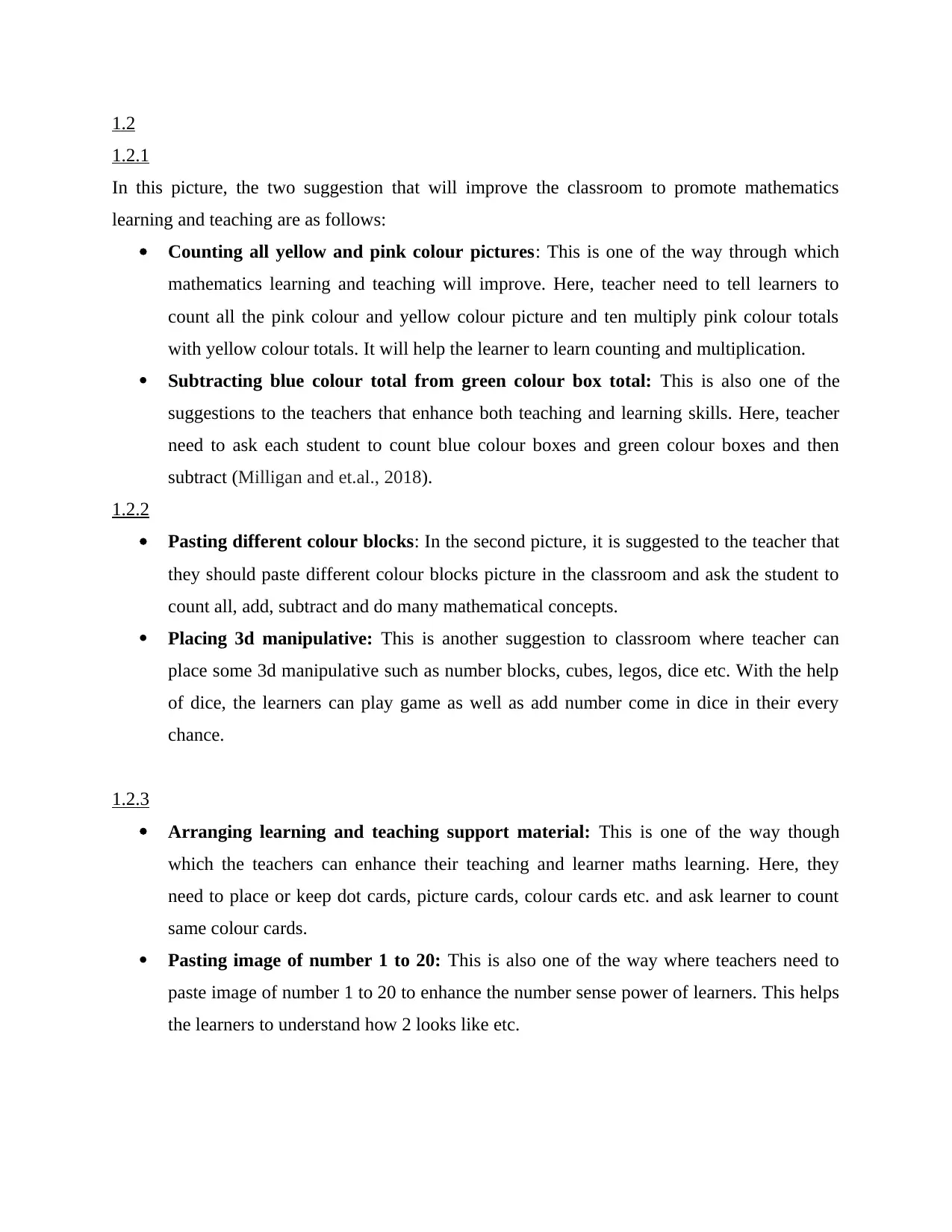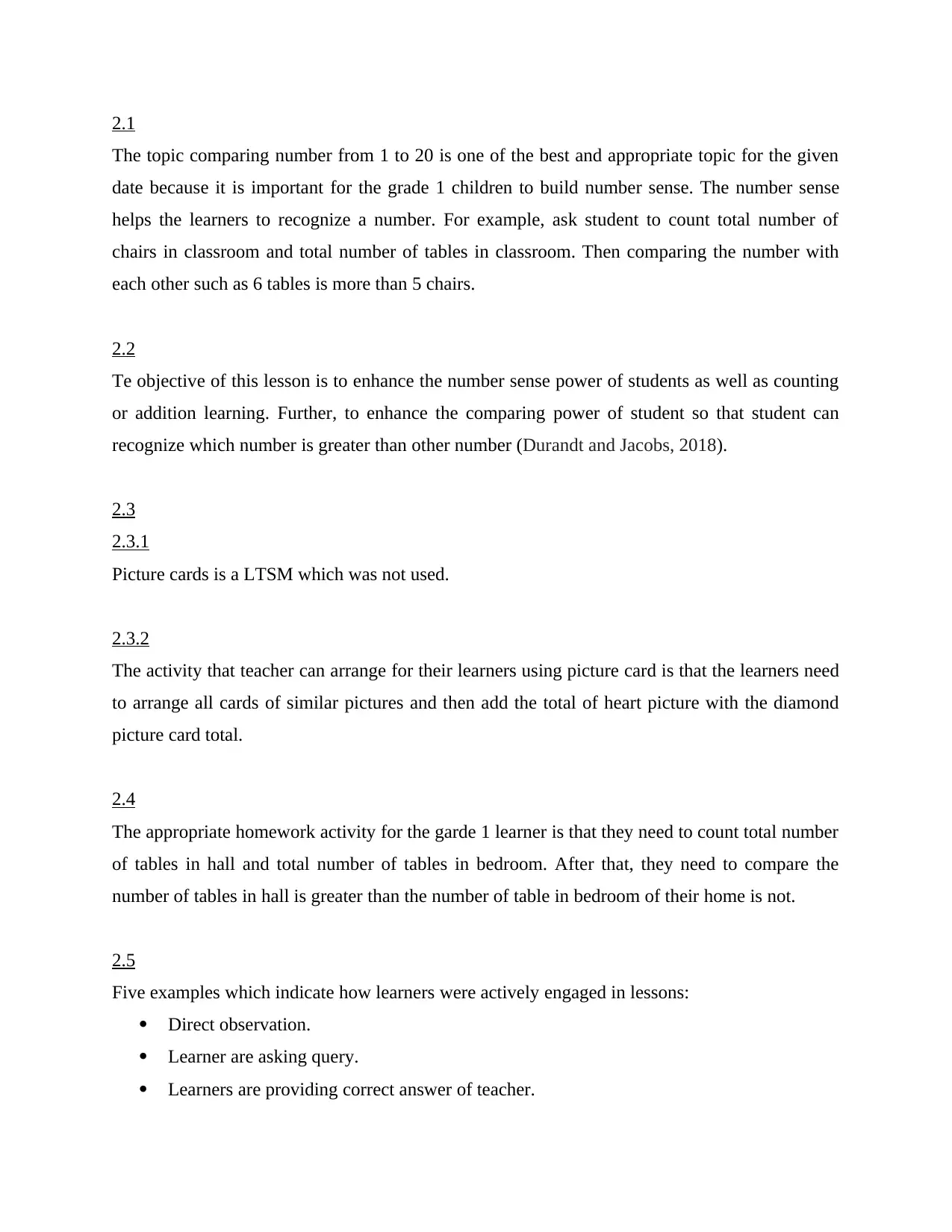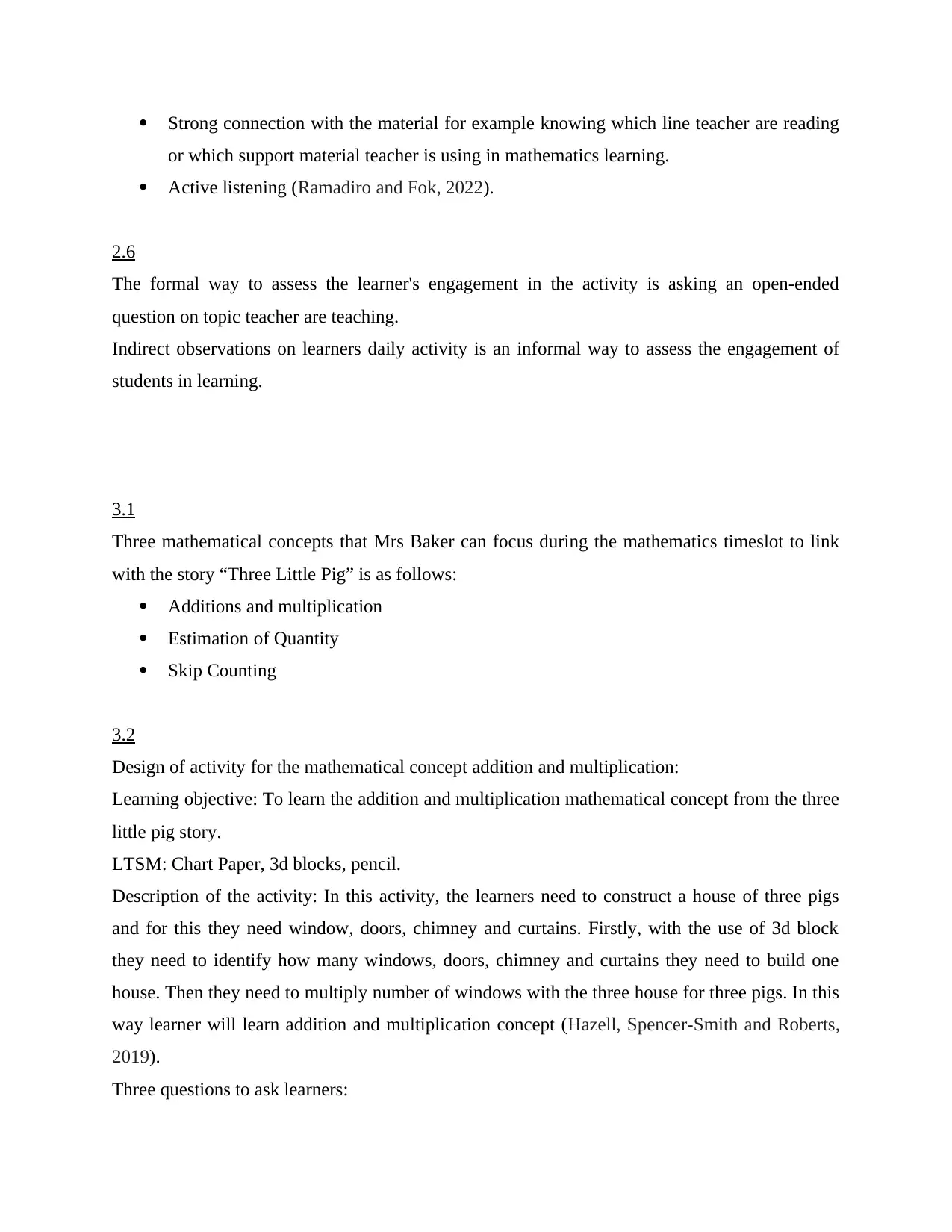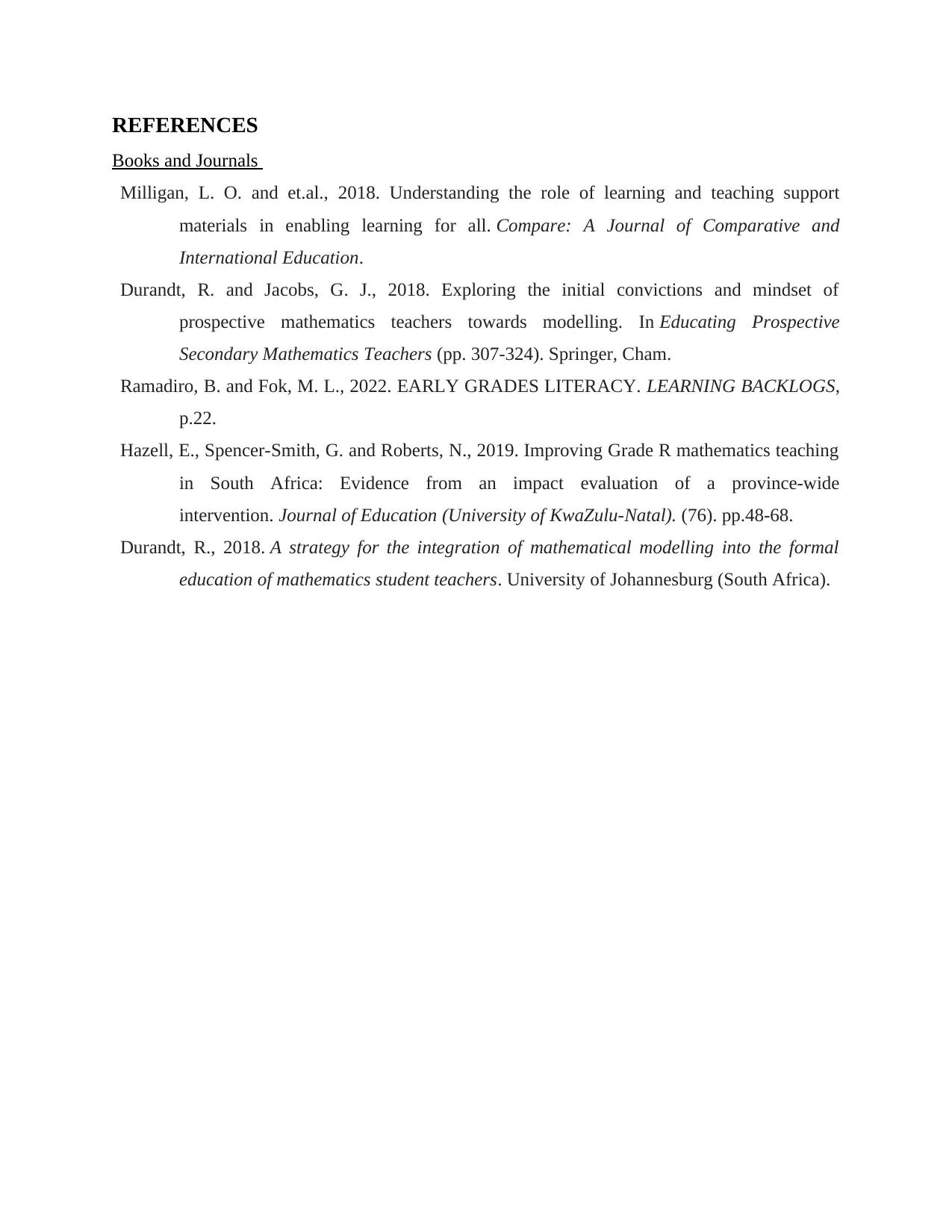Grade 1 Mathematics Assignment: Comparing Numbers 1 to 20 Analysis
VerifiedAdded on 2023/06/10
|9
|1441
|170
Homework Assignment
AI Summary
This assignment focuses on comparing numbers from 1 to 20, designed for a Grade 1 mathematics curriculum. The document includes a table of contents and explores various aspects of number sense and mathematical concepts. It provides suggestions for improving classroom activities to enhance learning, such as counting and multiplication exercises using visual aids. The assignment covers the objectives of the lesson, which aims to improve students' number sense and ability to compare numbers. It also details activities using picture cards, homework assignments, and examples of active student engagement. Furthermore, the assignment delves into mathematical concepts such as addition, multiplication, and estimation, linking these concepts to a story context. It describes activities designed to teach these concepts using LTSM (Learning and Teaching Support Materials). Finally, it discusses the progression of learning from term 1 to term 4, outlining appropriate objectives for each term, and detailing how a teacher might use LTSM to deliver the curriculum. References to relevant books and journals are also provided.

Comparing numbers from 1
to 20
to 20
Paraphrase This Document
Need a fresh take? Get an instant paraphrase of this document with our AI Paraphraser

TABLE OF CONTENT
1.2.................................................................................................................................................4
1.2.1..............................................................................................................................................4
1.2.2..............................................................................................................................................4
1.2.3..............................................................................................................................................4
2.1.................................................................................................................................................5
2.2.................................................................................................................................................5
2.3.................................................................................................................................................5
2.3.1..............................................................................................................................................5
2.3.2..............................................................................................................................................5
2.4.................................................................................................................................................5
2.5.................................................................................................................................................5
2.6.................................................................................................................................................6
3.1.................................................................................................................................................6
3.2.................................................................................................................................................6
3.3.................................................................................................................................................7
4.1.................................................................................................................................................7
4.2.................................................................................................................................................7
4.3.................................................................................................................................................7
REFERENCES................................................................................................................................8
1.2.................................................................................................................................................4
1.2.1..............................................................................................................................................4
1.2.2..............................................................................................................................................4
1.2.3..............................................................................................................................................4
2.1.................................................................................................................................................5
2.2.................................................................................................................................................5
2.3.................................................................................................................................................5
2.3.1..............................................................................................................................................5
2.3.2..............................................................................................................................................5
2.4.................................................................................................................................................5
2.5.................................................................................................................................................5
2.6.................................................................................................................................................6
3.1.................................................................................................................................................6
3.2.................................................................................................................................................6
3.3.................................................................................................................................................7
4.1.................................................................................................................................................7
4.2.................................................................................................................................................7
4.3.................................................................................................................................................7
REFERENCES................................................................................................................................8

⊘ This is a preview!⊘
Do you want full access?
Subscribe today to unlock all pages.

Trusted by 1+ million students worldwide

1.2
1.2.1
In this picture, the two suggestion that will improve the classroom to promote mathematics
learning and teaching are as follows:
Counting all yellow and pink colour pictures: This is one of the way through which
mathematics learning and teaching will improve. Here, teacher need to tell learners to
count all the pink colour and yellow colour picture and ten multiply pink colour totals
with yellow colour totals. It will help the learner to learn counting and multiplication.
Subtracting blue colour total from green colour box total: This is also one of the
suggestions to the teachers that enhance both teaching and learning skills. Here, teacher
need to ask each student to count blue colour boxes and green colour boxes and then
subtract (Milligan and et.al., 2018).
1.2.2
Pasting different colour blocks: In the second picture, it is suggested to the teacher that
they should paste different colour blocks picture in the classroom and ask the student to
count all, add, subtract and do many mathematical concepts.
Placing 3d manipulative: This is another suggestion to classroom where teacher can
place some 3d manipulative such as number blocks, cubes, legos, dice etc. With the help
of dice, the learners can play game as well as add number come in dice in their every
chance.
1.2.3
Arranging learning and teaching support material: This is one of the way though
which the teachers can enhance their teaching and learner maths learning. Here, they
need to place or keep dot cards, picture cards, colour cards etc. and ask learner to count
same colour cards.
Pasting image of number 1 to 20: This is also one of the way where teachers need to
paste image of number 1 to 20 to enhance the number sense power of learners. This helps
the learners to understand how 2 looks like etc.
1.2.1
In this picture, the two suggestion that will improve the classroom to promote mathematics
learning and teaching are as follows:
Counting all yellow and pink colour pictures: This is one of the way through which
mathematics learning and teaching will improve. Here, teacher need to tell learners to
count all the pink colour and yellow colour picture and ten multiply pink colour totals
with yellow colour totals. It will help the learner to learn counting and multiplication.
Subtracting blue colour total from green colour box total: This is also one of the
suggestions to the teachers that enhance both teaching and learning skills. Here, teacher
need to ask each student to count blue colour boxes and green colour boxes and then
subtract (Milligan and et.al., 2018).
1.2.2
Pasting different colour blocks: In the second picture, it is suggested to the teacher that
they should paste different colour blocks picture in the classroom and ask the student to
count all, add, subtract and do many mathematical concepts.
Placing 3d manipulative: This is another suggestion to classroom where teacher can
place some 3d manipulative such as number blocks, cubes, legos, dice etc. With the help
of dice, the learners can play game as well as add number come in dice in their every
chance.
1.2.3
Arranging learning and teaching support material: This is one of the way though
which the teachers can enhance their teaching and learner maths learning. Here, they
need to place or keep dot cards, picture cards, colour cards etc. and ask learner to count
same colour cards.
Pasting image of number 1 to 20: This is also one of the way where teachers need to
paste image of number 1 to 20 to enhance the number sense power of learners. This helps
the learners to understand how 2 looks like etc.
Paraphrase This Document
Need a fresh take? Get an instant paraphrase of this document with our AI Paraphraser

2.1
The topic comparing number from 1 to 20 is one of the best and appropriate topic for the given
date because it is important for the grade 1 children to build number sense. The number sense
helps the learners to recognize a number. For example, ask student to count total number of
chairs in classroom and total number of tables in classroom. Then comparing the number with
each other such as 6 tables is more than 5 chairs.
2.2
Te objective of this lesson is to enhance the number sense power of students as well as counting
or addition learning. Further, to enhance the comparing power of student so that student can
recognize which number is greater than other number (Durandt and Jacobs, 2018).
2.3
2.3.1
Picture cards is a LTSM which was not used.
2.3.2
The activity that teacher can arrange for their learners using picture card is that the learners need
to arrange all cards of similar pictures and then add the total of heart picture with the diamond
picture card total.
2.4
The appropriate homework activity for the garde 1 learner is that they need to count total number
of tables in hall and total number of tables in bedroom. After that, they need to compare the
number of tables in hall is greater than the number of table in bedroom of their home is not.
2.5
Five examples which indicate how learners were actively engaged in lessons:
Direct observation.
Learner are asking query.
Learners are providing correct answer of teacher.
The topic comparing number from 1 to 20 is one of the best and appropriate topic for the given
date because it is important for the grade 1 children to build number sense. The number sense
helps the learners to recognize a number. For example, ask student to count total number of
chairs in classroom and total number of tables in classroom. Then comparing the number with
each other such as 6 tables is more than 5 chairs.
2.2
Te objective of this lesson is to enhance the number sense power of students as well as counting
or addition learning. Further, to enhance the comparing power of student so that student can
recognize which number is greater than other number (Durandt and Jacobs, 2018).
2.3
2.3.1
Picture cards is a LTSM which was not used.
2.3.2
The activity that teacher can arrange for their learners using picture card is that the learners need
to arrange all cards of similar pictures and then add the total of heart picture with the diamond
picture card total.
2.4
The appropriate homework activity for the garde 1 learner is that they need to count total number
of tables in hall and total number of tables in bedroom. After that, they need to compare the
number of tables in hall is greater than the number of table in bedroom of their home is not.
2.5
Five examples which indicate how learners were actively engaged in lessons:
Direct observation.
Learner are asking query.
Learners are providing correct answer of teacher.

Strong connection with the material for example knowing which line teacher are reading
or which support material teacher is using in mathematics learning.
Active listening (Ramadiro and Fok, 2022).
2.6
The formal way to assess the learner's engagement in the activity is asking an open-ended
question on topic teacher are teaching.
Indirect observations on learners daily activity is an informal way to assess the engagement of
students in learning.
3.1
Three mathematical concepts that Mrs Baker can focus during the mathematics timeslot to link
with the story “Three Little Pig” is as follows:
Additions and multiplication
Estimation of Quantity
Skip Counting
3.2
Design of activity for the mathematical concept addition and multiplication:
Learning objective: To learn the addition and multiplication mathematical concept from the three
little pig story.
LTSM: Chart Paper, 3d blocks, pencil.
Description of the activity: In this activity, the learners need to construct a house of three pigs
and for this they need window, doors, chimney and curtains. Firstly, with the use of 3d block
they need to identify how many windows, doors, chimney and curtains they need to build one
house. Then they need to multiply number of windows with the three house for three pigs. In this
way learner will learn addition and multiplication concept (Hazell, Spencer-Smith and Roberts,
2019).
Three questions to ask learners:
or which support material teacher is using in mathematics learning.
Active listening (Ramadiro and Fok, 2022).
2.6
The formal way to assess the learner's engagement in the activity is asking an open-ended
question on topic teacher are teaching.
Indirect observations on learners daily activity is an informal way to assess the engagement of
students in learning.
3.1
Three mathematical concepts that Mrs Baker can focus during the mathematics timeslot to link
with the story “Three Little Pig” is as follows:
Additions and multiplication
Estimation of Quantity
Skip Counting
3.2
Design of activity for the mathematical concept addition and multiplication:
Learning objective: To learn the addition and multiplication mathematical concept from the three
little pig story.
LTSM: Chart Paper, 3d blocks, pencil.
Description of the activity: In this activity, the learners need to construct a house of three pigs
and for this they need window, doors, chimney and curtains. Firstly, with the use of 3d block
they need to identify how many windows, doors, chimney and curtains they need to build one
house. Then they need to multiply number of windows with the three house for three pigs. In this
way learner will learn addition and multiplication concept (Hazell, Spencer-Smith and Roberts,
2019).
Three questions to ask learners:
⊘ This is a preview!⊘
Do you want full access?
Subscribe today to unlock all pages.

Trusted by 1+ million students worldwide

Q1. How many windows, doors, chimney and curtains required for one house?
Q.2 How many windows are required for 3 houses?
Q.3 How many windows, doors, chimney and curtains are required for three houses?
3.3
The knowledge of English + class exercise + creative examples + careful explanation is a
part of pedagogical content knowledge.
Understanding of student conceptions of the subject.
Linking the theoretical concept with mathematical concept.
They have general pedagogical content knowledge.
Knowledge of purposes of education on Mrs Baker.
4.1
The learning progresses to term 1 to term 4 is that students of grade 2 able to enhance there
understanding level in topic count forwards and backwards. For example, in term 1 learners
known only ones number between 0 and 100 but in term 4 they learn 1s from any number
between 0 and 200 or many more.
4.2
The objective that will be appropriate for Term 3 learning is to provide the learning of skip
counting 1s, 10s, 2s, 3s, 5s and 4s. Back counting, count forward or on as well as the number
which are multiplication of 10, 5, 2, 3 and 4 (Durandt, 2018).
4.3
In the Level 2 of the counting learners should be to achieve the objective described or mentioned
in above 4.2.
4.4
In order to teach the requirements and topics mentioned in extract, the teacher will use the
LTSM, black board, chart paper, 3d images and blocks etc. The learner will use the 3d blocks to
Q.2 How many windows are required for 3 houses?
Q.3 How many windows, doors, chimney and curtains are required for three houses?
3.3
The knowledge of English + class exercise + creative examples + careful explanation is a
part of pedagogical content knowledge.
Understanding of student conceptions of the subject.
Linking the theoretical concept with mathematical concept.
They have general pedagogical content knowledge.
Knowledge of purposes of education on Mrs Baker.
4.1
The learning progresses to term 1 to term 4 is that students of grade 2 able to enhance there
understanding level in topic count forwards and backwards. For example, in term 1 learners
known only ones number between 0 and 100 but in term 4 they learn 1s from any number
between 0 and 200 or many more.
4.2
The objective that will be appropriate for Term 3 learning is to provide the learning of skip
counting 1s, 10s, 2s, 3s, 5s and 4s. Back counting, count forward or on as well as the number
which are multiplication of 10, 5, 2, 3 and 4 (Durandt, 2018).
4.3
In the Level 2 of the counting learners should be to achieve the objective described or mentioned
in above 4.2.
4.4
In order to teach the requirements and topics mentioned in extract, the teacher will use the
LTSM, black board, chart paper, 3d images and blocks etc. The learner will use the 3d blocks to
Paraphrase This Document
Need a fresh take? Get an instant paraphrase of this document with our AI Paraphraser

learn addition, subtraction. With the help of images and picture the learner will learn about how
numbers look like which enhance their number sense.
numbers look like which enhance their number sense.

REFERENCES
Books and Journals
Milligan, L. O. and et.al., 2018. Understanding the role of learning and teaching support
materials in enabling learning for all. Compare: A Journal of Comparative and
International Education.
Durandt, R. and Jacobs, G. J., 2018. Exploring the initial convictions and mindset of
prospective mathematics teachers towards modelling. In Educating Prospective
Secondary Mathematics Teachers (pp. 307-324). Springer, Cham.
Ramadiro, B. and Fok, M. L., 2022. EARLY GRADES LITERACY. LEARNING BACKLOGS,
p.22.
Hazell, E., Spencer-Smith, G. and Roberts, N., 2019. Improving Grade R mathematics teaching
in South Africa: Evidence from an impact evaluation of a province-wide
intervention. Journal of Education (University of KwaZulu-Natal). (76). pp.48-68.
Durandt, R., 2018. A strategy for the integration of mathematical modelling into the formal
education of mathematics student teachers. University of Johannesburg (South Africa).
Books and Journals
Milligan, L. O. and et.al., 2018. Understanding the role of learning and teaching support
materials in enabling learning for all. Compare: A Journal of Comparative and
International Education.
Durandt, R. and Jacobs, G. J., 2018. Exploring the initial convictions and mindset of
prospective mathematics teachers towards modelling. In Educating Prospective
Secondary Mathematics Teachers (pp. 307-324). Springer, Cham.
Ramadiro, B. and Fok, M. L., 2022. EARLY GRADES LITERACY. LEARNING BACKLOGS,
p.22.
Hazell, E., Spencer-Smith, G. and Roberts, N., 2019. Improving Grade R mathematics teaching
in South Africa: Evidence from an impact evaluation of a province-wide
intervention. Journal of Education (University of KwaZulu-Natal). (76). pp.48-68.
Durandt, R., 2018. A strategy for the integration of mathematical modelling into the formal
education of mathematics student teachers. University of Johannesburg (South Africa).
⊘ This is a preview!⊘
Do you want full access?
Subscribe today to unlock all pages.

Trusted by 1+ million students worldwide
1 out of 9
Your All-in-One AI-Powered Toolkit for Academic Success.
+13062052269
info@desklib.com
Available 24*7 on WhatsApp / Email
![[object Object]](/_next/static/media/star-bottom.7253800d.svg)
Unlock your academic potential
Copyright © 2020–2025 A2Z Services. All Rights Reserved. Developed and managed by ZUCOL.